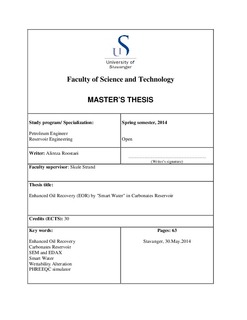| dc.contributor.author | Roostaei, Alireza | |
| dc.date.accessioned | 2014-09-22T12:44:51Z | |
| dc.date.available | 2014-09-22T12:44:51Z | |
| dc.date.issued | 2014-05-30 | |
| dc.identifier.uri | http://hdl.handle.net/11250/220930 | |
| dc.description | Master's thesis in Petroleum engineering | nb_NO |
| dc.description.abstract | Characterization of the reservoir limestone cores has to be specified to obtain possible solution (designed water) based EOR technique to enhance the oil production. In this project a parametric study was performed to observe the effects of 3 different brines that contained phosphate, sulfate and borate ions on chalk cores and deciding, which brine is the best candidate to use as imbibing brine for limestone cores. The phosphate brine was not suitable due to precipitation of phosphate with brines containing divalent ions. Borate brine had lower and slower oil production compare to sulfate brine. Finally it was decided to select the sulfate brine for the limestone cores experiment.
Reservoir cores based on same properties, were divided in three different groups. The chromatography wettability tests were used to study the potential of wettability alteration and specify if there is any water-wet surface in limestone cores for the smart water to be active. SEM and EDAX of cores were done to show the mineralogy, physical and chemical characteristics of cores. The heterogeneity and homogeneity of pores can be observed clearly. EDAX can shows the type of core that, if it is dolomitic or limestone (pure calcite). The information from surface reactivity test, SEM and EDAX of cores was important for the selection of the brines. For dolomitic and limestone cores, it was decided to select SWd20 and SW0NaCl x 4SO42- respectively as imbibing brines.
Initially the cores were imbibed by formation brine to establish an initial level of production. Core 10E (group 1) and 14C (group 2) had the highest and lowest oil recovery in this step. After that, the imbibing brines were changed to SWd20 for core 10E and SW0NaCl x 4SO42- for cores 14C and 37C as smart water. Increment in oil recovery of core 10E by SWd20, was more than cores 14C and 37C by SW0NaCl x 4SO42-.
The core 37C was placed in to the steel cell at high temperature with the same imbibing fluid. By starting the steel cell spontaneous imbibition at high temperature, a small amount the oil recovery of core 37C increased mainly due to thermal expansion.
PHREEQC simulator predicted that, the sulfate concentration decreases by increasing the temperature in atmospheric and reservoir pressure for both brines. The analysis of sulfate concentration of the imbibing brine by ion chromatography after the experiment showed that there was no sulfate precipitation. | nb_NO |
| dc.language.iso | eng | nb_NO |
| dc.publisher | University of Stavanger, Norway | nb_NO |
| dc.relation.ispartofseries | Masteroppgave/UIS-TN-IPT/2014; | |
| dc.rights | Attribution 3.0 Norway | * |
| dc.rights.uri | http://creativecommons.org/licenses/by/3.0/no/ | * |
| dc.subject | petroleumsteknologi | nb_NO |
| dc.subject | SEM and EDAX | nb_NO |
| dc.subject | PHREEQC simulator | nb_NO |
| dc.subject | enhanced oil recovery | nb_NO |
| dc.subject | EOR | nb_NO |
| dc.subject | smart water | nb_NO |
| dc.subject | wettability | nb_NO |
| dc.subject | carbonates reservoir | nb_NO |
| dc.title | Enhanced oil recovery (EOR) by "smart water" in carbonates reservoir | nb_NO |
| dc.type | Master thesis | nb_NO |

